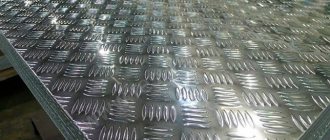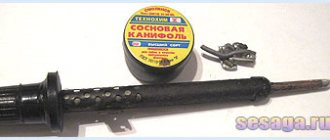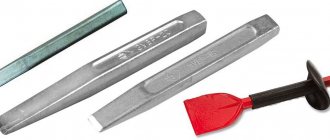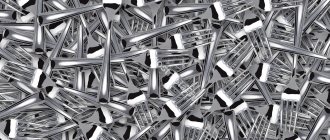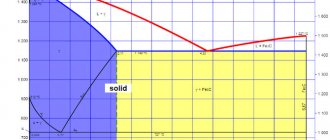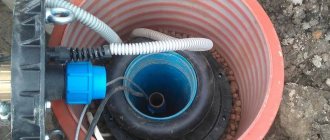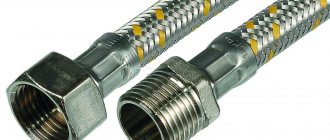Metal sheets are the most popular rolled metal products. Construction, repairs and other areas of human activity cannot do without flat rolled steel, which is used in different ways. Products made from metal sheets surround us everywhere in everyday life: car body, roofing, building facades, ventilation systems, art products, steel pipes - all this is made from sheet steel. Therefore, you can buy sheet steel as a blank for the further manufacture of all kinds of goods or as a finished building material.
Metal sheets are selected for specific tasks based on their thickness, type of steel used and other features. They are flat, rectangular-shaped products that, due to their flexibility and ductility, can be processed into specific shapes. In many cases, special treatments are added to the composition or carried out in order to preserve and protect the metal product from external atmospheric and climatic influences, increase its resistance to impacts or improve surface properties.
Sheet steel is classified according to sheet thickness as thin sheet (from 0.35 to 3.9 mm) and thick sheet (from 4 to 160 mm).
Sheet steel by rolling type
Based on the type of rolling, products are classified into cold-rolled and hot-rolled. They can then be subjected to treatments such as heat treatment and skin tempering to increase their yield strength or zinc coating to protect against corrosion.
Cold rolled steel
The manufacturing process involves placing a metal alloy between rollers located at the top and bottom. They deform the metal into a thinner piece or sheet than its original size.
The blank for cold-rolled products is hot-rolled. Its properties are improved: the metal is washed with acid at the manufacturing plant before the final rolling is completed. The final stage of obtaining the material consists of heat treatment, known as annealing. Cold rolled steel is harder and stronger than hot rolled steel and looks more presentable. Cold rolled steel sheets and coils are commonly used where dimensional tolerances, strength and surface finish are critical.
Areas of application of cold-rolled sheet metal products: ♦ Metal furniture. ♦ Automotive components. ♦ Electronic equipment. ♦ Household appliances and components. ♦ Lighting lamps. ♦ Construction of buildings.
Hot rolled steel
Products of this type are subjected to rolling processes at temperatures above 750 degrees Celsius. Due to their unsightly appearance, they are usually used where finishing is not critical to the project. This is one of the types of steel most often used for the manufacture of parts of mechanically welded structures, for bending or profiling, assembly by welding, and even for artistic sculptures. The color variations on the steel sheets give character to the entire sculpture.
Cold rolled sheet steel
Cold rolled steel is not highly elastic. She doesn't keep her shape well. Therefore, the sheets are used in their original form. At the same time, cold-rolled steel has a comparatively more presentable appearance and increased strength. It is made from hot-rolled billets.
To do this, they are rolled between rollers, due to which the sheets are of uniform thickness and have a silvery metallic color. After all, after rolling, the scale that forms during the hot processing stage is removed from the sheets. To do this, use the etching technique using acids or a jet of special gas under high pressure. Due to all this, cold-rolled sheets are more expensive than hot-rolled sheets.
In the production of various types of cold-rolled sheet steel, depending on the chemical composition, the following GOST standards are used:
- GOST 11268-76. The base here is high quality alloy steel. The brands used are 25KhGSA, 30KhGSA, 12Kh2NMFA and others.
- GOST 9045-93. This standard is developed for steel up to 3.9 mm thick on a low carbon base. These are brands: 08kp, 08Yu and 08ps.
- GOST 19904-90. This is the standard for the thickness of cold rolled steel. Thickness can be increased accuracy (AT), normal accuracy (BT), and high accuracy (HT).
- GOST 16523-97. The standard regulates the characteristics of cold-rolled thin sheets based on high-quality and ordinary steel.
In order to successfully purchase cold-rolled sheets that meet production requirements, it is worth studying the specified standards.
Sheet steel by processing method
Galvanized sheets
Galvanized steel has a zinc coating, so it is a more durable material that is resistant to atmospheric and aggressive influences. It is widely used in construction and component manufacturing due to its characteristics of durability and stability over a long service life.
Galvanized sheets are used: ♦ In construction. ♦ Mechanical engineering, automotive industry. ♦ In the manufacture of pipes. ♦ For the production of roofing materials. ♦ In the chemical and food industries. ♦ For external decoration of balconies, walls, fences.
Sheet metal: types, characteristics and purpose
The main qualitative characteristics of sheet metal are the following indicators:
- Manufacturing technology. All types of stainless steel sheets are created by hot or cold deformation. At the same time, hot-rolled options are more in demand due to their excellent set of physical and mechanical properties.
- Dimensions. Sheets may have different thicknesses, widths or heights; the standard values are specified in GOST, but each manufacturer can introduce a new product category with its own dimensions.
- Rolling accuracy, edge trimming and flatness. These characteristics also depend on the brand of the product, and manufacturers offer several sheet metal options for these values.
Separate points are the grade of steel used and the presence of additional processing. The main products of rolled sheets are the following types of metal sheets:
- Smooth. Sheet metal with a painted surface can have different thicknesses and overall dimensions, and its distinctive advantage is its attractive appearance. The main area of use is finishing work.
- Smooth galvanized. After forming, the metal undergoes an additional stage of processing with a zinc compound to improve performance characteristics. The alloy becomes resistant to corrosion, withstands temperature changes and has a long service life. The scope of use of such a product is much wider, and different types of galvanized sheets make it possible to select raw materials for any production needs.
- Perforated. The metal sheet is processed on a special machine, and a through pattern of holes appears on its surface. Depending on the purpose, the diameter and location of the holes may vary, but the main area of use of such a product does not extend beyond finishing work.
- Stainless. One of the most popular rolled metal products, which is used both for finishing and for the production of various parts. The distinctive quality of the material lies in its heat resistance and corrosion resistance, so the finished structure can last a long time and retain its strength in any environmental conditions.
- Profiled. Decorative sheets with a corrugated surface are widely used for finishing various structures and can be used for wall or roof cladding.
Advantages and disadvantages
When choosing a specific type of sheet metal, you need to take into account a set of mandatory performance characteristics. Depending on the manufacturing technology and sheet thickness, the physical and mechanical properties of the metal can differ significantly from each other. For example, cold-rolled types of profiled sheets are made with a thickness of no more than 4 mm, so you cannot count on a high strength index.
The main advantages of using such material of any kind are the following qualities:
- Manufacturability. The metal sheet lends itself well to forming, stamping or welding. The correct geometric shape makes it possible to make accurate calculations for material consumption or work with structures of complex shapes.
- Wear resistance. All types of galvanized sheets are in high demand in areas where aggressive components and chemical compounds are used. However, corrosion resistance, thermal conductivity or strength depend entirely on the grade of steel used.
- Diversity. Sheets can have a cut edge, a painted surface and different thicknesses, so it is possible to choose a material for any application.
We should talk about the disadvantages of sheet metal only from the point of view of the suitability of the material used for its intended purpose. For example, all types of perforated sheets are resistant to atmospheric factors, corrosion and mechanical stress. However, the presence of holes excludes the insulating property, and such metal can only be used as a finishing material.
Area of use
A wide range of performance characteristics is the main advantage of this material. Sheet metal is used for industrial purposes and acts as the main raw material in the manufacture of various equipment. The same type of rolled metal can be used for construction purposes and for finishing the premises. High-quality metal in sheet format is indispensable in the following industries:
- mechanical and instrument engineering;
- shipbuilding and aviation;
- construction;
- Agriculture;
- wide range production.
Some types of profile sheets are used for cladding roofs and facades; corrugated sheets are used for finishing steps and for decorating the interior.
If you are planning construction of any category, then you will definitely need high-quality metal sheets. You can choose an option to suit your requirements at UTK-Steel. The company's consultants will help you choose a product for the designated task.
Where else is sheet steel used?
Sheet metal has many different uses in interior and exterior design. It is capable of soundproofing and optimizing air, so it is excellent for ceilings and also for dividing spaces. In addition, elements such as tables, shelves, partitions, railings, drawers, containers, etc. are made from sheet steel. The small thickness of the product makes it possible to bend it, creating a variety of bent or profile products.
Thick sheets are used to create metal frames, in the construction of welded structures, and in the manufacture of various parts.
Classification and marking of rolled sheets
According to the production method, sheet steel is divided into
- Hot rolled;
- Cold rolled.
By sheet thickness
- Thin-sheet rolled products - with sheet thickness up to 3.9 mm;
- Thick sheets - with sheet thickness from 4 to 160 mm.
By type of rental supply
- In rolls;
- In sheets.
Rolled products can consist of no more than 2 pieces (separate or connected by a weld).
By coverage availability
- Uncoated sheet metal;
- Galvanized sheet metal;
- Sheet metal with polymer coating.
Rolling accuracy for thicknesses up to 12 mm
- A - increased accuracy;
- B - normal accuracy.
By flatness
- PN - normal flatness;
- PU - improved flatness;
- PV - high flatness;
- PO - especially high flatness.
By type or nature of the edge
- BUT - with unedged edge;
- O - with trimmed edge.
By size
- I - indicating the dimensions of thickness, width and length;
- II - indicating dimensions by thickness;
- III - indicating dimensions that are multiples of width and length;
- IV - indicating the measured dimensions in width and length.
According to intended use
- ХШ - for cold stamping;
- HP - for cold profiling;
- PC - for painting (trained);
- OH - general purpose.
According to the ability to draw
- N - normal hood;
- G - deep drawing;
- VG - very deep drawing.
By uniformity of coating thickness
- NR - with normal thickness variation;
- UR - with reduced thickness variation.
GOST and TU for sheet metal. Features of different classes, types of sheet steel
The produced range, dimensions, characteristics and use of rolled sheets are regulated by state standards (GOST) and technical conditions (TU).
Cold rolled sheet
- GOST 19904-90 — Cold-rolled sheet products. Assortment
- GOST 16523-97 — Rolled thin-sheet carbon steel of high quality and ordinary quality for general purposes
- GOST 9045-93 — Cold-rolled thin sheets of low-carbon quality steel for cold stamping
- GOST 17066-94 — Rolled thin sheets of high strength steel
- GOST 503-81 — Cold-rolled strip made of low-carbon steel
Cold rolled sheets are produced by cold rolling ductile steel in a rolling mill. Cold rolled sheets are available in thicknesses from 0.35 to 5 mm with varying hardness.
Features of cold rolled sheets:
- excellent quality of the surface layer;
- high performance properties, resistance to thermal deformation during welding;
- does not require additional surface treatment for applying paint and varnish.
Cold rolled sheets are widely used in industry. These in turn are used to make:
- perforated sheets;
- roofing galvanized sheets;
- corrugated sheeting
Cold-rolled sheets are ideal for the manufacture of high-precision metal structures due to their resistance to thermal deformation during welding.
Hot rolled sheet
- GOST 19903-74 — Hot-rolled sheet products. Assortment
- GOST 16523-97 — Rolled thin-sheet carbon steel of high quality and ordinary quality for general purposes
- GOST 14637-89 - Rolled thick sheets of carbon steel of ordinary quality
- GOST 8568-77 — Steel sheets with rhombic and lenticular corrugation
- GOST 19281-89 - Rolled steel of high strength (low alloy)
- GOST 1577-93 - Rolled thick sheets and wide sheets from structural high-quality steel
- GOST 5520-79 — Rolled sheets of carbon and low-alloy steel for boilers and pressure vessels
Hot rolled sheets are produced by hot rolling steel on a rolling mill followed by heat treatment.
It, in turn, is divided into:
- Thin-sheet rolled products with a thickness of up to 3.9 mm - GOST 16523-89, are produced in rolls with a sheet thickness of 1.2 mm and sheets with a cut edge with a thickness of 0.4 mm. We also produce high-quality structural sheet metal with etched and unetched surfaces.
- Thick plates with a thickness from 4 to 160 mm - GOST 19903-74.
According to GOST 1577-93, structural sheet metal is produced with the possibility of subsequent heat treatment.
Also, hot-rolled metal is divided into two types:
- low-alloy hot-rolled sheet;
- hot-rolled structural sheet.
Low-alloy sheet is made from low-carbon steel and is used in industry and construction for the manufacture of welded metal structures. Due to their low cost, low-alloy sheets are widely used for the manufacture of non-critical parts in light and heavy industry. They are widely used in the manufacture of seam pipelines and bridge riveted metal structures.
Structural rolled metal products are made from alloy carbon steel and are used in the manufacture of critical parts for various machines and mechanisms in industry.
Features of Hot Rolled Steel Sheets:
- excellent weldability;
- corrosion resistance;
- heat resistance;
- high performance characteristics;
- high quality of the surface layer;
- ease of processing and at the same time resistance to mechanical damage.
Hot-rolled sheet is ideal for the manufacture of welded metal structures installed outdoors and structures resistant to high temperatures.
Corrugated sheet
Corrugated sheet metal is a type of sheet steel, on one side of which a corrugation is applied in the form of a pattern: rhombic corrugation (diamond diagonals are 25-30 mm by 60-70 mm) and lenticular corrugation (the gap between the corrugations is 20, 25 and 30 mm).
Sheet thickness is indicated excluding embossing.
To produce the sheet, carbon steel is used in accordance with GOST 380-88.
The degree of accuracy of corrugated sheets: A - high and B - normal.
Corrugated sheet is used as a floor covering with anti-slip properties. They are also used for decorative purposes as cladding panels.
Galvanized sheet metal
- GOST 14918-80 - Galvanized thin sheet steel from continuous lines
- GOST 52246-2004 — Rolled hot-dip galvanized sheets
Galvanized steel is produced from carbon cold-rolled coiled steel. This is rolled metal with an anti-corrosion zinc coating applied to one or both surfaces.
Galvanized sheets are widely used in roofing, cladding of buildings and structures, food industry and medicine.
Galvanized steel can be produced:
- KR - with a crystallization pattern;
- MT – without crystallization pattern.
Band
GOST 103-2006 - Long-rolled hot-rolled steel strip
